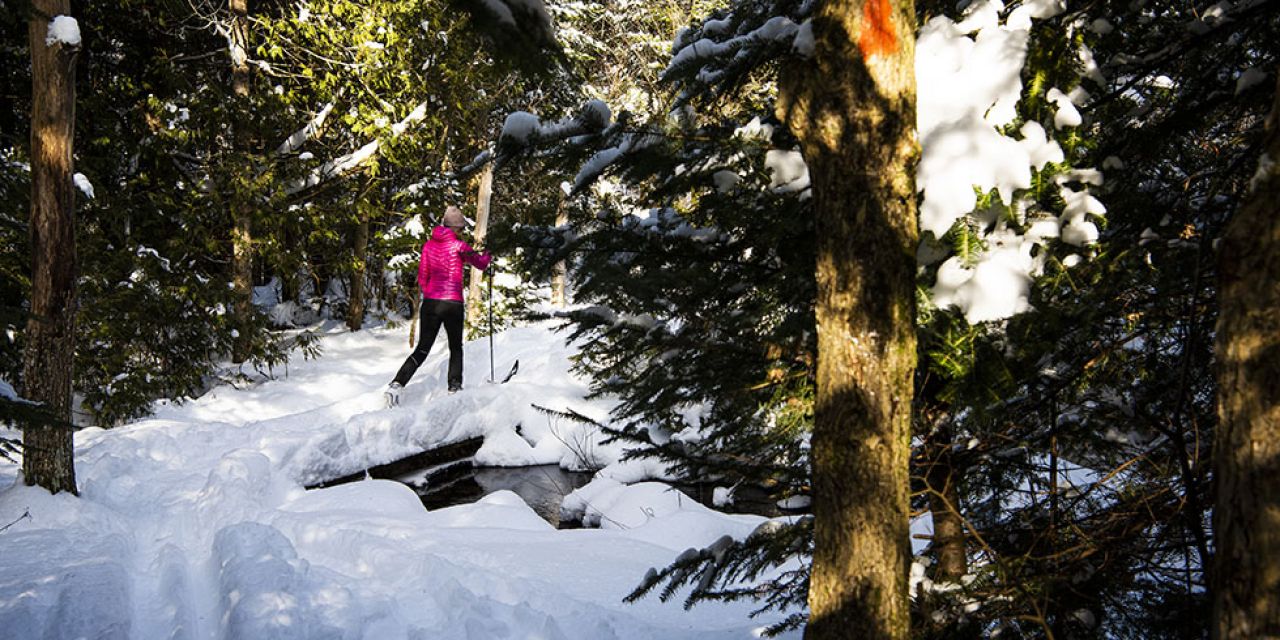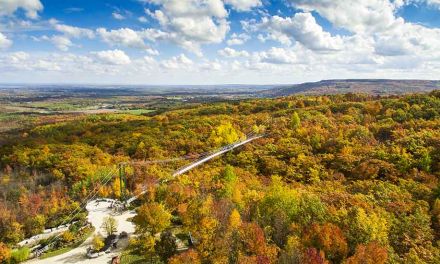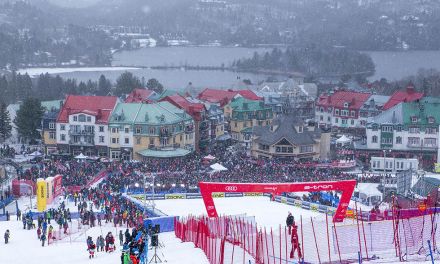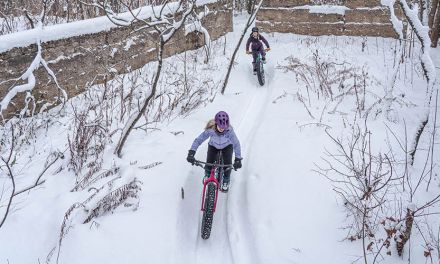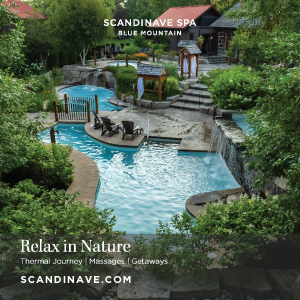POWDERY PURSUITS
Story by Kate MacLennan, photography by Clay Dolan
Amidst the hustle and bustle of the 21st century, Nordic skiing might be just what you need to keep on track.
There are essentially two kinds of people in Southern Ontario: those who flee winter and those who wait impatiently throughout the other three seasons for its return. For the latter, the snow is as much an invitation as a tantalizing challenge. After all, it takes a certain amount of dedication—not to mention layers and equipment—to head willingly into a deep freeze with the intention of enjoying it. But, oh, the world of delicious adrenaline that’s unlocked is so worth it when we drop into that alpine bowl, blaze through those slalom gates, or trim the face of an icy freshwater wave.
Nordic skiing, on the other hand… it’s not as instantly clear for some why one would go through the palaver of donning those skis, boots, and what appears to be a sorely under-insulated leotard just to head out in biting cold and travel across the snow at a relative snail’s pace. Until you realize that’s kind of the point.
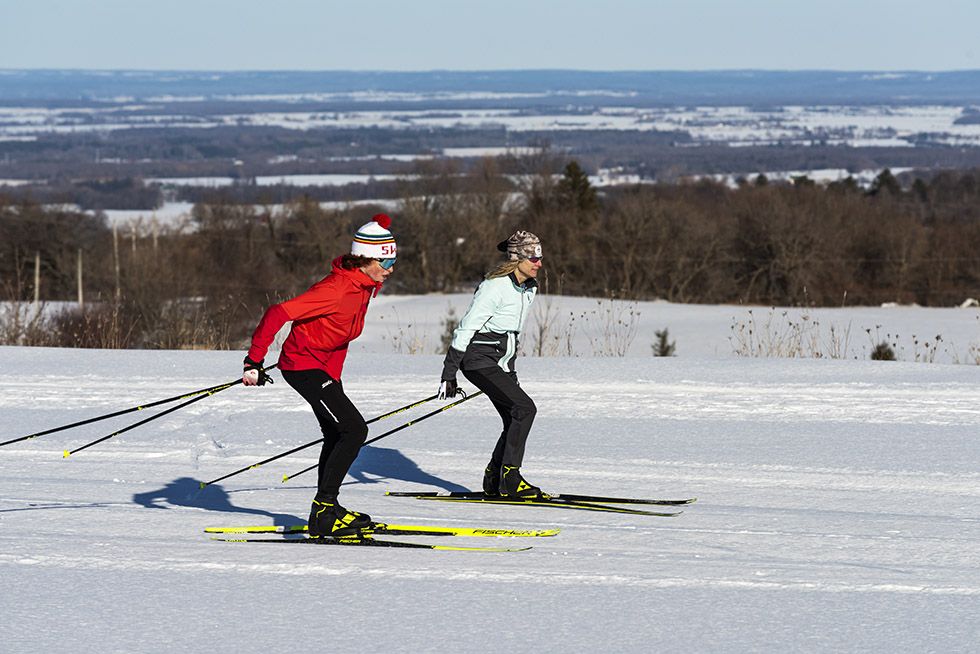
I remember reading the novel Zen and the Art of Motorcycle Maintenance for the first time in high school, and being struck by the notion author Robert Pirsig presents. He posits that a way to pull more joy from life as we move through it is to discover that sweet spot where one can be both utterly rational and utterly present at the same time. In the story, the male narrator is on a motorcycle ride across the US, but he could have easily been Nordic skiing.
For the leisure Nordic skier, the experience is fifty percent a physical grind and fifty percent an intangible feeling of being completely in the moment. It’s about subjecting yourself to a methodical, determined, relentless, grit-your-teeth-and-push-and-glide-and-pump-those-arms slog (often in the name of a fantastic cardio workout that results in a derrière you could bounce a loonie off!). Yet it’s also about losing yourself in the simple, unyielding sound of skis pushing against the snow, the rhythm of your breathing, and the little puff of water vapor that escapes with every warm exhale (often in the name of a fantastic way to clear your head of the myriad thoughts that typically clutter it). And that’s the magic. Out on the trail, there’s room—kilometre after kilometre of it—for one’s inner nature to be awakened, confronted, and explored, possibly even transcended in the pursuit of personal contentment.
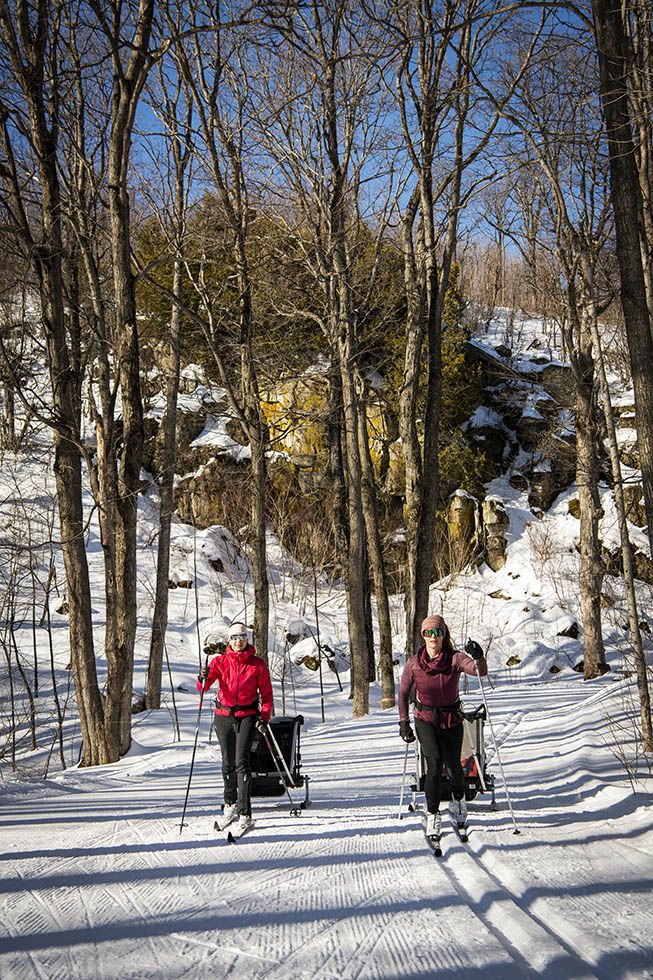
If that all sounds too heavy, then let me convince you that Nordic skiing on and around the Niagara Escarpment is as much a romantic pursuit as an intellectual one. The sounds of the forest are a treat for ears regularly filled with the ubiquitous hum and drone of technology—that is, if there even are sounds. Snowflakes are six-sided crystals filled with open spaces, and every one of those tiny spaces traps air that absorbs sound waves, which then can’t bounce and make their way to our over-taxed oreille. Nordic skiers can happily pull that blanket of silence over them. All the better to be out skiing when it starts to snow. I’ve read that a Japanese onomatopoeia to describe the sound of falling snow is shin shin—a word for a sound of no sound. How beautiful.
Speaking of beautiful, views that become accessible on Nordic skis seem almost too obvious to mention, and the trails of the Scenic Caves Nordic Centre at the highest point on the Escarpment boast unmatched panoramas over farmland and Georgian Bay. Now imagine turning from a lookout and heading back into the forest, the boreal needleleaf trees surrounding you with their boughs and their sharp but sweet reassuring scent.
The Japanese believe so firmly in the health benefits of immersing oneself in a forest that they also coined a name for it: Shinrin-yoku, which translates roughly to “forest bathing”, defined as a physiological and psychological exercise focusing on sensory engagement to connect with nature. I wonder how often Nordic skiers, devoid of distraction, physically spent and emotionally full, are tempted to untangle the question: what is a human if not also nature?
Professional Nordic athletes tend to fill those moments with different thoughts, and Escarpment clubs have produced skiers at regional, provincial, national and international levels. Highlands Trailblazer operates out of Highlands Nordic facility and runs programs starting at age four right up to competitive Nordic and Biathlon programs. Georgian Bay Nordic, located at Sawmills Trail in Hepworth and affiliated with the Bruce Ski Club, coaches from age 10.
Georgian Bay Nordic alumni Julian Smith grew up in Oxenden, near Wiarton, and is an aspiring Olympian (with sights set firmly on the 2026 Winter Games in Italy), former Canadian National Team member, and leader at the National Team Development Centre in Thunder Bay. “Cross-country skiing at a high level is brutally difficult. You can be at the World Championships, the highest echelon of our sport, and yet you go down a hill into an abyss of silence. It’s not like hockey or basketball—you’re not in a stadium with a billion fans—you’re alone with your breath and your heartbeat and your screaming muscles. You’re alone a lot of the time,” he says.
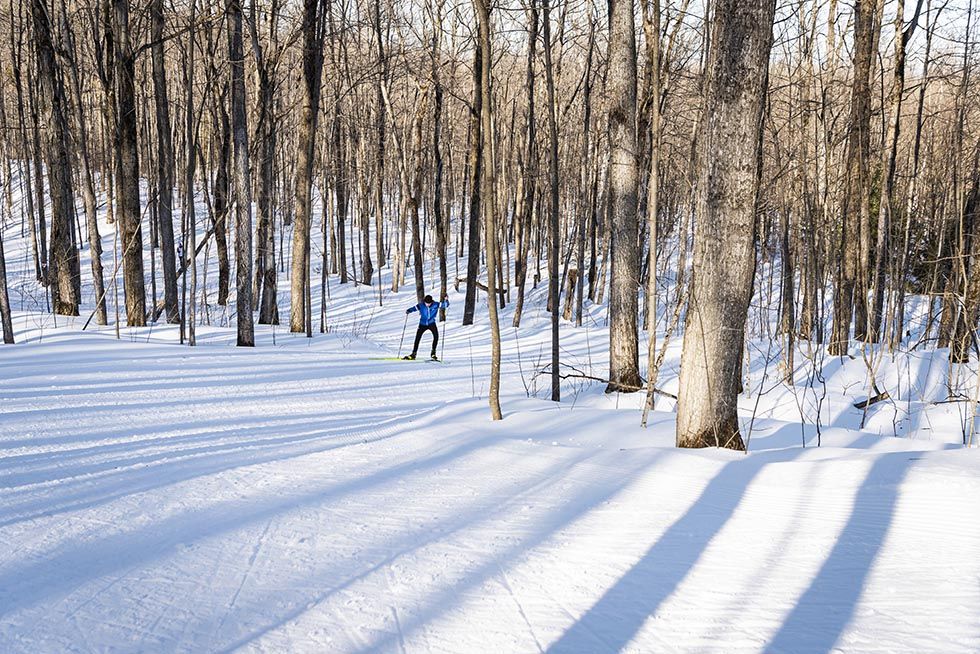
It’s all about balancing his thinking, he says. “A wandering mind is hard to deal with out there. From a performance standpoint, I get through those moments of silence with a singular focus: that goal of skiing faster and faster. Then the emotional part is two-fold. It comes down to the fact that you had better love this sport and let that passion carry you, but also knowing I’ve spent 800 hours training with friends, had countless calls with my coach and sports psychologist, and have shared my biggest goals and deepest fears with my family, my partner, and my friends. So, when those moments come along, like they do almost every day, I know I’m not actually alone; I’m just physically the only one there.”
Every moment, of course, will pass and another will take its place. If the next moment sees muscles cramping, toes turning numb in ski boots, cold hands resisting gripping ski poles, or the track ahead feeling like it’s a hundred miles from the parked car or finish line, an outsider may wonder, why would I take up Nordic skiing? Only to reflect on the mental and physical health benefits, the appreciation of a nature, the time spent with family and friends, and realize the answer is also a question: why wouldn’t I?
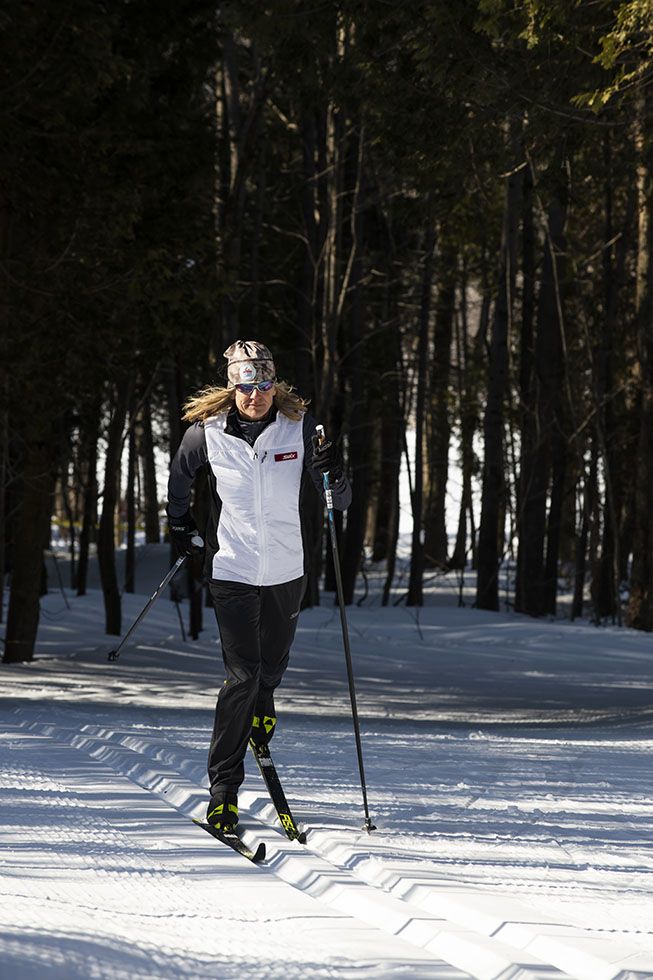
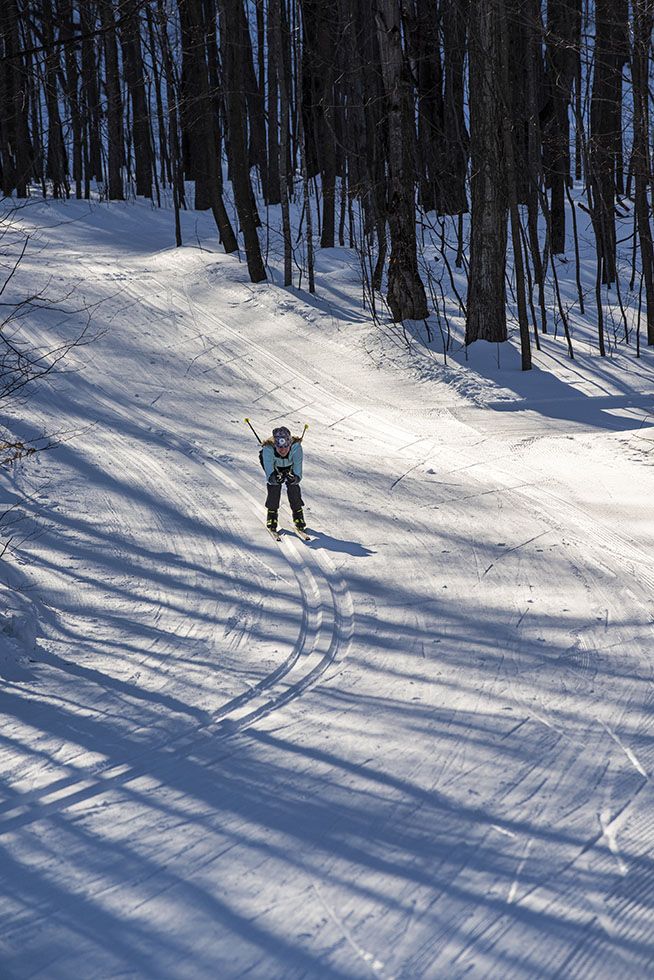
Want to go for a glide?
Nordic skiing and cross-country skiing are essentially different names for the same thing, in which the ski boot is fixed to the binding in a way that lets the heel rise off the ski. The category is further divided into two techniques: classic and skate. (Telemark is a third subsection of Nordic skiing that combines alpine and classic on a slope.)
In classic skiing, movement is forward (similar to walking or running), skis are parallel, and speed is often more leisurely. Classic skiers can use groomed parallel track or cut their own track through deeper snow when required.
In skate skiing the movement is a kick step to the side. It’s a more technical movement and also a greater workout that requires a wide, packed snow trail but doesn’t require a lot of snow. Speed is about 6% faster than classic skiing, and skate skis are shorter than classic skis.
From a development standpoint, classic skiing is the place to start. (For kiddos, the Jackrabbits program is an excellent place to learn and develop a love for the sport.) Most skiers will show they’re ready for skate skiing when they start to push out of the parallel tracks to get more speed. Once you’ve decided which category suits you there are several places, such as Scenic Caves and Sun Trail Outfitters in Hepworth, to rent the gear you’ll need for a test run. Here’s a few other places to get out there and get started.
BRUCE SKI CLUB – A $65 season pass at Bruce Ski Club gets you access to its 13 kilometres of trail for all levels, daily grooming of the Hepworth skate track, night skiing, and social events, as well as exchange days to explore other private ski club terrain.
COLPOYS SKI TRAIL – Just north of Wiarton, this 11.5-kilometre trail network runs through sheltered woods and open fields and offers breathtaking views of the Niagara Escarpment and Colpoy’s Bay. bruceskiclub.ca
GLENELG NORDIC SKI CLUB – Offering 25 kilometres of groomed track set trails for classic skiing, the Glenelg trails include moderately hilly terrain and travel through mature hardwood forest. Children under 18 ski free when their parent has a membership. glenelgnordicskiclub.org
HIGHLANDS NORDIC – With 25-kilometres of groomed classic and skate ski trails, as well as night skiing, Highlands Nordic provides the perfect training ground for beginners and competitive skiers. Adults $35, children 7 and under are free. highlandsnordic.ca
KOLAPORE UPLANDS – The 60-kilometre network of trails in Kolapore provides some of the best cross-country skiing in the region—and an authentic backcountry is experience. Grooming is completed by the first skier of the day, so be prepared to break fresh track. Because the trail network is quite extensive, downloading or purchasing a trail map is recommended. kolaporetrails.org
OWEN SOUND CROSS COUNTRY CLUB – The OSCCC maintains the 9.6-kilometre trail network at Massie Hills located between Meaford and Owen Sound. Trails are groomed at least twice weekly for classic skiing only and provide a backcountry skiing experience—often with two sets of tracks. massiehills.com
SAUBLE SKI CLUB – The Sauble Beach Cross Country Ski Club offers some of the best classic Nordic ski trails in Ontario. The club has 19 kilometres of trail that is groomed and track set for classic skiing. skisauble.freehostia.com
SAWMILL NORDIC CENTRE – Located on Highway 6 between Shallow Lake and Hepworth, the Sawmill Nordic Centre (operating with Bruce Ski Club) offers 11-kilometres of groomed trail for both classic and skate ski. The “Jack Rabbit” trail is even lit for night skiing. bruceskiclub.ca
SCENIC CAVES – Located at the very top of the Escarpment, Scenic Caves offers breath-taking views and 27-kilometres of professionally maintained trails for both classic and skate skiing. sceniccaves.com
STONEY ISLAND CONSERVATION AREA – A 6-kilometre network for both classic and skate skiing. svca.on.ca
TOMAHAWK RECREATIONAL COMPLEX – The Town of Blue Mountains will again be grooming a hard-packed loop trail at the Tomahawk Recreational Complex throughout the winter season. thebluemountains.ca
WASAGA BEACH PROVINCIAL PARK – The Wasaga Breach Provincial Park offers over 30-kilometres of groomed trails. Experts can challenge themselves on the High Dunes Trail while beginners can enjoy the more leisurely Blueberry Trail. wasagabeachpark.com
Also check out: ontariotrails.on.ca, ontarioparks.com, visitgrey.ca, brucecounty.on.ca, and southgeorgianbay.ca

